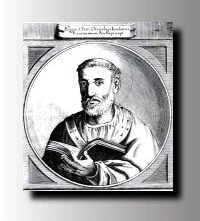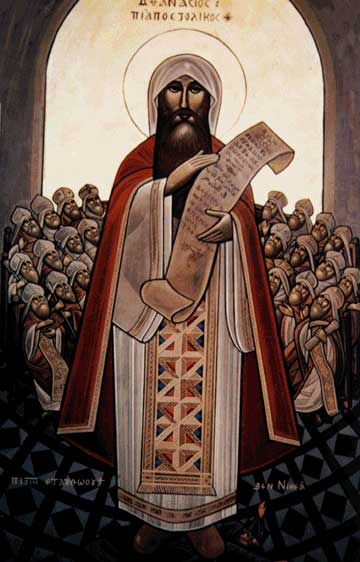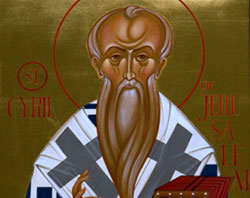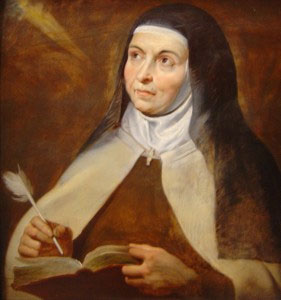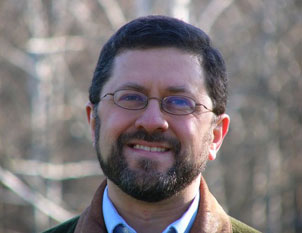 Mike Aquilina shares with Bruce and I the life and teaches of St. John Chrysostom.
Mike Aquilina shares with Bruce and I the life and teaches of St. John Chrysostom.
[powerpress]
John Chrysostom born in 347, his father died soon after his birth, leaving his mother,  Anthusa, a widow at the age of 20.  She never married, sticking with the teachings of St. Paul to stay unmarried; she was a devout Christian and was very committed to her son; they loved and cared for each other very much. She would raise up a son who had a great love for Jesus Christ and who would become of the greatest preachers of all time (imagine him the Billy Graham of his day). He would become the Archbishop of Constantinople, and an important Early Church Father. His denunciation of abuse of authority by both ecclesiastical and political leaders would get him in big trouble, but it didn’t stop him. After his death (or, according to some sources, during his life) he was given the Greek surname chrysostomos, meaning “golden mouthed”, rendered in English as Chrysostom.
Many Christian Churches love and claim St. John Chrysostom. The Orthodox and Eastern Catholic Churches honor him as a saint and count him among the Three Holy Hierarchs, together with Saints Basil the Great and Gregory Nazianzus. He is recognized by the Eastern Orthodox Church and Roman Catholic Church as a saint and Doctor of the Church. Churches of the Western tradition, including the Roman Catholic Church, some Anglican provinces, and parts of the Lutheran Church, commemorate him on 13 September. Some Lutheran and many Anglican provinces commemorate him on the traditional Eastern feast day of 27 January. The Coptic Orthodox Church of Alexandria recognizes John Chrysostom as a saint.
Spiritual Writings:
 - Homilies on the Gospel of St. Matthew
-Â Homilies on Acts
-Â Homilies on Romans
-Â Homilies on First Corinthians
-Â Homilies on Second Corinthians
-Â Homilies on Ephesians
-Â Homilies on Philippians
-Â Homilies on Colossians
-Â Homilies on First Thessalonians
-Â Homilies on Second Thessalonians
-Â Homilies on First Timothy
-Â Homilies on Second Timothy
-Â Homilies on Titus
-Â Homilies on Philemon
-Â Commentary on Galatians
-Â Homilies on the Gospel of John
-Â Homilies on the Epistle to the Hebrews
-Â Homilies on the Statues
-Â No One Can Harm the Man Who Does Not Injure Himself
-Â Two Letters to Theodore After His Fall
-Â Letter to a Young Widow
-Â Homily on St. Ignatius
-Â Homily on St. Babylas
-Â Homily Concerning “Lowliness of Mind”
-Â Instructions to Catechumens
-Â Three Homilies on the Power of Satan
-Â Homily on the Passage “Father, if it be possible . . .”
-Â Homily on the Paralytic Lowered Through the Roof
-Â Homily on the Passage “If your enemy hunger, feed him.”
-Â Homily Against Publishing the Errors of the Brethren
-Â First Homily on Eutropius
-Â Second Homily on Eutropius (After His Captivity)
-Â Four Letters to Olympias
-Â Letter to Some Priests of Antioch
-Â Correspondence with Pope Innocent I
-Â On the Priesthood.
.
Prayer is the light of the soul
A reading from the homilies of St John Chrysostom (Hom 6 on Prayer)
“There is nothing more worthwhile than to pray to God and to converse with him, for prayer unites us with God as his companions. As our bodily eyes are illuminated by seeing the light, so in contemplating God our soul is illuminated by him. Of course the prayer I have in mind is no matter of routine, it is deliberate and earnest. It is not tied down to a fixed timetable; rather it is a state which endures by night and day.
Our soul should be directed in God, not merely when we suddenly think of prayer, but even when we are concerned with something else. If we are looking after the poor, if we are busy in some other way, or if we are doing any type of good work, we should season our actions with the desire and the remembrance of God. Through this salt of the love of God we can all become a sweet dish for the Lord. If we are generous in giving time to prayer, we will experience its benefits throughout our life.
Prayer is the light of the soul, giving us true knowledge of God. It is a link mediating between God and man. By prayer the soul is borne up to heaven and in a marvellous way embraces the Lord. This meeting is like that of an infant crying on its mother, and seeking the best of milk. The soul longs for its own needs and what it receives is better than anything to be seen in the world.
Prayer is a precious way of communicating with God, it gladdens the soul and gives repose to its affections. You should not think of prayer as being a matter of words. It is a desire for God, an indescribable devotion, not of human origin, but the gift of God’s grace. As Saint Paul says: we do not know how to pray as we ought, but the Spirit himself intercedes for us with sighs too deep for words.
Anyone who receives from the Lord the gift of this type of prayer possesses a richness that is not to be taken from him, a heavenly food filling up the soul. Once he has tasted this food, he is set alight by an eternal desire for the Lord, the fiercest of fires lighting up his soul.
To set about this prayer, paint the house of your soul with modesty and lowliness and make it splendid with the light of justice. Adorn it with the beaten gold of good works and, for walls and stones, embellish it assiduously with faith and generosity. Above all, place prayer on top of this house as its roof so that the complete building may be ready for the Lord. Thus he will be received in a splendid royal house and by grace his image will already be settled in your soul.
Â
Tags: doctor of the church, eastern catholic churches, father of the church, fathers mike, heaven, John Chrysostom, mike aquilina, mother, prayer, st john chrysostom
This entry was posted on Friday, September 13th, 2013 at 7:12 am
You can follow any responses to this entry through the RSS 2.0 feed.
Dr. Matthew Bunson discusses the life, times and work of  St. Athanasius of Alexandria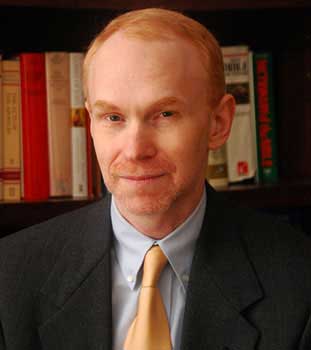
[powerpress]
For more on St. Athanasius of Alexandria and his teachings
AthanasiusÂ
-Â On the Incarnation of the Word
-Â Deposition of Arius
-Â Statement of Faith
-Â On Luke 10:22 (Matthew 11:27)
-Â Circular Letter
-Â Apologia Contra Arianos
-Â De Decretis
-Â De Sententia Dionysii
-Â Vita S. Antoni (Life of St. Anthony)
-Â Ad Episcopus Aegypti et Libyae
-Â Apologia ad Constantium
-Â Apologia de Fuga
-Â Historia Arianorum
-Â Four Discourses Against the Arians
-Â De Synodis
-Â Tomus ad Antiochenos
-Â Ad Afros Epistola Synodica
-Â Historia Acephala
-Â Letters
Athanasius was undoubtedly one of the most important and revered early Church Fathers. But this great Saint was above all the impassioned theologian of the Incarnation of the Logos, the Word of God who – as the Prologue of the fourth Gospel says – “became flesh and dwelt among us” (Jn 1: 14).
For this very reason Athanasius was also the most important and tenacious adversary of the Arian heresy, which at that time threatened faith in Christ, reduced to a creature “halfway” between God and man, according to a recurring tendency in history which we also see manifested today in various forms.
In all likelihood Athanasius was born in Alexandria, Egypt, in about the year 300 A.D. He received a good education before becoming a deacon and secretary to the Bishop of Alexandria, the great Egyptian metropolis. As a close collaborator of his Bishop, the young cleric took part with him in the Council of Nicaea, the first Ecumenical Council, convoked by the Emperor Constantine in May 325 A.D. to ensure Church unity. The Nicene Fathers were thus able to address various issues and primarily the serious problem that had arisen a few years earlier from the preaching of the Alexandrian priest, Arius.
With his theory, Arius threatened authentic faith in Christ, declaring that the Logos was not a true God but a created God, a creature “halfway” between God and man who hence remained for ever inaccessible to us. The Bishops gathered in Nicaea responded by developing and establishing the “Symbol of faith” [“Creed”] which, completed later at the First Council of Constantinople, has endured in the traditions of various Christian denominations and in the liturgy as the Niceno-Constantinopolitan Creed.
In this fundamental text – which expresses the faith of the undivided Church and which we also recite today, every Sunday, in the Eucharistic celebration – the Greek term homooúsiosis featured, in Latin consubstantialis: it means that the Son, the Logos, is “of the same substance” as the Father, he is God of God, he is his substance. Thus, the full divinity of the Son, which was denied by the Arians, was brought into the limelight.
For more visit Vatican.va
Dr. Matthew Bunson, Senior Fellow of the St. Paul Center for Biblical Theology, is one of the United States’ leading authorities on the papacy and the Church.
His books include: The Encyclopedia of Catholic History; The Encyclopedia of Saints; Papal Wisdom; All Shall Be Well; Encyclopedia of the Roman Empire; and The Angelic Doctor: The Life and World of St. Thomas Aquinas; The Pope Encyclopedia; We Have a Pope! Benedict XVI, the first Catholic biography of the Holy Father in the English language; the Encyclopedia of U.S. Catholic History; Pope Francis. Â His also the editor of OSV’s “The Catholic Answer” magazine.
Tags: Church, church fathers, faith, matthew bunson, work
This entry was posted on Friday, September 6th, 2013 at 11:15 am
You can follow any responses to this entry through the RSS 2.0 feed.
 Episode 15 – Great Works in Western Literature with Joseph Pearce – St. Augustine
Episode 15 – Great Works in Western Literature with Joseph Pearce – St. Augustine
[powerpress]
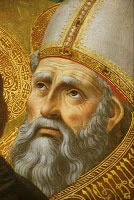 The Confessions of Saint Augustine is considered one of the greatest Christian classics of all time. It is an extended poetic, passionate, intimate prayer that Augustine wrote as an autobiography sometime after his conversion, to confess his sins and proclaim God’s goodness. Just as his first hearers were captivated by his powerful conversion story, so also have many millions been over the following sixteen centuries. His experience of God speaks to us across time with little need of transpositions.
The Confessions of Saint Augustine is considered one of the greatest Christian classics of all time. It is an extended poetic, passionate, intimate prayer that Augustine wrote as an autobiography sometime after his conversion, to confess his sins and proclaim God’s goodness. Just as his first hearers were captivated by his powerful conversion story, so also have many millions been over the following sixteen centuries. His experience of God speaks to us across time with little need of transpositions.
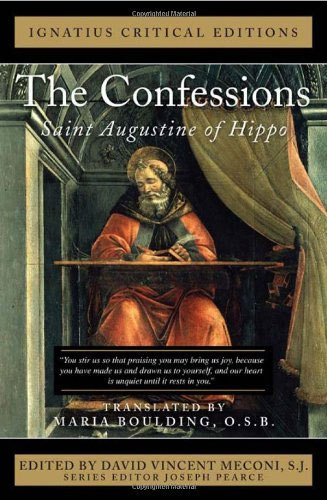 Based on the Ignatius Critical Edition, this series examines, from the Judeo-Christian perspective, the life, the times, and influence of authors of great works in literature .
Based on the Ignatius Critical Edition, this series examines, from the Judeo-Christian perspective, the life, the times, and influence of authors of great works in literature .
Joseph Pearce is currently the Writer-in-Residence and Visiting Fellow at Thomas More College of Liberal Arts in Merrimack, New Hampshire. He is also Visiting Scholar at Mount Royal Academy in Sunapee, New Hampshire. He is also Visiting Scholar at Mount Royal Academy in Sunapee, New Hampshire. He is  co-editor of the Saint Austin Review (or StAR), an international review of Christian culture, literature, and ideas published in England (Family Publications) and the United States (Sapientia Press). He is also the author of many books, including literary biographies of Solzhenitsyn, J. R. R. Tolkien, C. S. Lewis, G. K. Chesterton, and Oscar Wilde.
To learn more about the authors and titles available in the Ignatius Critical Editions
Tags: catholic, catholic podcast, catholic prayer, cathollc spirituality, conversion, joseph pearce, New Hampshire, prayer
This entry was posted on Tuesday, September 3rd, 2013 at 8:28 am
You can follow any responses to this entry through the RSS 2.0 feed.
We talk with Mike Aquilina  about St. Gregor the Great, a father of the Church.
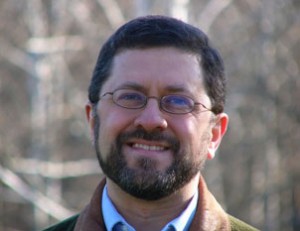 [powerpress]
[powerpress]
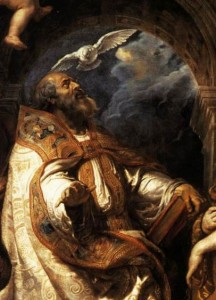 St. Gregory the Great…the tradition of the Church considers him one of the four great doctors of the Latin Church. Born in Rome, Italy, in AD 540, St. Gregory was the son of Gordianus, a wealthy senator, and Silvia, who later became a saint. (Saints make saints after all…).
St. Gregory the Great…the tradition of the Church considers him one of the four great doctors of the Latin Church. Born in Rome, Italy, in AD 540, St. Gregory was the son of Gordianus, a wealthy senator, and Silvia, who later became a saint. (Saints make saints after all…).
His youth was a troubled one. In his writings he chronicles the perpetual seiges that Rome endured at the hands of the barbarians.  Those nasty Lombards! Pillaging, raping, massacring, they would plague the Church and the people of the land for 200 years, you name it..by any standard, they were bad!
Saint Gregory became the Prefect of Rome at the age of thirty, and the people loved him because he was able to keep them safe. A few years later, like his parents, he gave his wealth away. He became a Benedictine monk. But the pope of the time, recalled him to Rome to serve as a deacon and to help the city, which was again attacked by the Lombards.
On the third day of September in 590, after he had first been ordained a priest, Saint Gregory was consecrated Pope and Bishop of Rome, in Saint Peter’s Basilica. He was the first monk to become Pope.  The Holy Spirit didn’t waste anytime moving him to service!
Through Saint Leander and his brother, Saint Isidore of Seville, as well as the martyr  Saint Hermenegild, Saint Gregory recovered Spain from the Arians. Through Queen Theodelinda, the wife of the Lombard King Agilulf, he was able to begin the conversion of the Lombard nation and the tempering of their ferocious and cruel natures. He won France back and began conversions in England. Saint Gregory was, above all else, a vigilant guardian of the Church’s doctrine, always the mark of a holy Pope. He ordained, early in his pontificate that the first four Ecumenical Councils of the Church should be treated with the respect given to the four Gospels. He worked unceasingly to stamp out heresy. He ordered that at the beginning of Lent the blessed ashes should be placed on the foreheads of the faithful, instead of only the head of the Pope — as had been the custom up to that time — and that the priest should repeat to each one, “Remember man, that dust thou art, and unto dust thou shalt return”. excerpted in part from an article by Sister Catherine Goddard Clark, M.I.C.M.
Saint Hermenegild, Saint Gregory recovered Spain from the Arians. Through Queen Theodelinda, the wife of the Lombard King Agilulf, he was able to begin the conversion of the Lombard nation and the tempering of their ferocious and cruel natures. He won France back and began conversions in England. Saint Gregory was, above all else, a vigilant guardian of the Church’s doctrine, always the mark of a holy Pope. He ordained, early in his pontificate that the first four Ecumenical Councils of the Church should be treated with the respect given to the four Gospels. He worked unceasingly to stamp out heresy. He ordered that at the beginning of Lent the blessed ashes should be placed on the foreheads of the faithful, instead of only the head of the Pope — as had been the custom up to that time — and that the priest should repeat to each one, “Remember man, that dust thou art, and unto dust thou shalt return”. excerpted in part from an article by Sister Catherine Goddard Clark, M.I.C.M.
He is known for his magnificent contributions to the Liturgy of the Mass and Office. The “Gregorian Chant” is named in honor of Saint Gregory’s patient labor in restoring the ancient chant of the Church and in setting down the rules to be followed so that Church music might more perfectly fulfill its function.
Saint Gregory the Great died on the twelfth of March, 604, at the age of sixty-four. He was canonized immediately after his death. Later, because of the volume, the extraordinary insight and the profundity of his writings, the depth and extent of his learning, and the heroic holiness of his life, the Church gratefully placed him beside Jerome and Ambrose and Augustine. Saint Gregory the Great became the fourth of the Church’s four great Doctors of the West. –
What would today be like without a little Gregorian Chant in honor of our St. Gregory?
 Spiritual Writings:
-Â Pastoral Rule
-Â Register of Letters
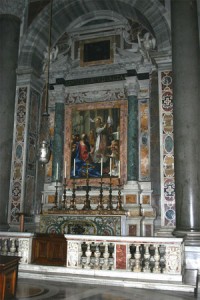 The altar of St. Gregory the Great at St. Peter’s in Rome. One of my favorite places to pray at the Vatican.Â
The altar of St. Gregory the Great at St. Peter’s in Rome. One of my favorite places to pray at the Vatican.Â
Tags: benedictine monk, bishop of rome, Church, ecumenical councils of the church, fathers mike, holy spirit, Latin Church, our sunday visitor, rome, saint gregory
This entry was posted on Tuesday, September 3rd, 2013 at 12:01 am
You can follow any responses to this entry through the RSS 2.0 feed.
The ultimate homiliest… so much so that he is known forever after as St. Peter Chrysologus (Peter of the Golden Words).   Born in 380 and died July 30 45o A.D. He was known for his short and inspired talks…make note: can be inspired AND short…wow! He spoke out against all those nasty heresies of the time (Aranism to name just one) and encouraged daily communion.
Take a listen to Mike Aquilina (speaking of Mr. Golden Words) talk to us about this time in history and all those “isms”, and how the Holy Spirit worked through the Church to battle those false teachings
[powerpress]
“He is The Bread sown in the virgin, leavened in the Flesh, molded in His Passion, baked in the furnace of the Sepulchre, placed in the Churches, and set upon the Altars, which daily supplies Heavenly Food to the faithful.”
“Today Christ works the first of his signs from heaven by turning water into wine. But water [mixed with wine] has still to be changed into the sacrament of his blood, so that Christ may offer spiritual drink from the chalice of his body, to fulfill the psalmist’s prophecy: How excellent is my chalice, warming my spirit.”
Tags: Church, Golden Words, heresy, holy spirit, mike aquilina, Resilient Church, st peter chrysologus, word among us press
This entry was posted on Tuesday, July 30th, 2013 at 10:57 am
You can follow any responses to this entry through the RSS 2.0 feed.
St. Athanasius is one of the great Father and Doctors of the Church…the Father of Orthodoxy. His extraordinary life is shared with us by Mike Aquilina. When we say “consubstantial” at mass it’s due in part to St. Athansius and the battle against the Arian Heresy. Take a listen and learn more…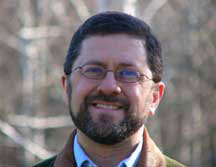
[powerpress]
More on the life of St. Athanasius from Pope Benedict at Vatican.va
GENERAL AUDIENCE
Paul VI Audience Hall
Wednesday, 20 June 2007
Continuing our revisitation of the great Teachers of the ancient Church, let us focus our attention today on St Athanasius of Alexandria.
>Only a few years after his death, this authentic protagonist of the Christian tradition was already hailed as “the pillar of the Church” by Gregory of Nazianzus, the great theologian and Bishop of Constantinople (Orationes, 21, 26), and he has always been considered a model of orthodoxy in both East and West.As a result, it was not by chance that Gian Lorenzo Bernini placed his statue among those of the four holy Doctors of the Eastern and Western Churches – together with the images of Ambrose, John Chrysostom and Augustine – which surround the Chair of St Peter in the marvellous apse of the Vatican Basilica.
Athanasius was undoubtedly one of the most important and revered early Church Fathers. But this great Saint was above all the impassioned theologian of the Incarnation of the Logos, the Word of God who – as the Prologue of the fourth Gospel says – “became flesh and dwelt among us” (Jn 1: 14).
For this very reason Athanasius was also the most important and tenacious adversary of the Arian heresy, which at that time threatened faith in Christ, reduced to a creature “halfway” between God and man, according to a recurring tendency in history which we also see manifested today in various forms.
In all likelihood Athanasius was born in Alexandria, Egypt, in about the year 300 A.D. He received a good education before becoming a deacon and secretary to the Bishop of Alexandria, the great Egyptian metropolis. As a close collaborator of his Bishop, the young cleric took part with him in the Council of Nicaea, the first Ecumenical Council, convoked by the Emperor Constantine in May 325 A.D. to ensure Church unity. The Nicene Fathers were thus able to address various issues and primarily the serious problem that had arisen a few years earlier from the preaching of the Alexandrian priest, Arius.
With his theory, Arius threatened authentic faith in Christ, declaring that the Logos was not a true God but a created God, a creature “halfway” between God and man who hence remained for ever inaccessible to us. The Bishops gathered in Nicaea responded by developing and establishing the “Symbol of faith” [“Creed”] which, completed later at the First Council of Constantinople, has endured in the traditions of various Christian denominations and in the liturgy as the Niceno-Constantinopolitan Creed.
In this fundamental text – which expresses the faith of the undivided Church and which we also recite today, every Sunday, in the Eucharistic celebration – the Greek term homooúsiosis featured, in Latin consubstantialis: it means that the Son, the Logos, is “of the same substance” as the Father, he is God of God, he is his substance. Thus, the full divinity of the Son, which was denied by the Arians, was brought into the limelight. (more…)
Tags: Church, faith, saints, St Athanasius
This entry was posted on Thursday, May 2nd, 2013 at 12:26 am
You can follow any responses to this entry through the RSS 2.0 feed.
Episode 22 Beginning to Pray: Â St. Catherine of Siena

[powerpress]
From Dr. Lilles’ “Beginning to Pray” Â blog site:
Catherine of Siena – passion for truth
She is an important figure for those who see a rediscovery of prayer as the force of renewal in the Church. Because she put her devotion to Christ first, she found herself with a spiritual mission to help restore the life and unity of Christ’s body. Some of her efforts met with a little success. But as she approached her death at the age of 33, her lifetime of effort in building up the Church seemed to be in vain. Corruption, scandal, cowardice – and most of all indifference – seemed to infect the Church even more. (For more on her life, go tohttp://www.newadvent.org/cathen/03447a.htm.) Yet she never lost hope and she persevered in prayer. This is because she understood the love and mercy of God.She was uneducated, but in 1377, by a miracle, she learned to write. Even so she retained secretaries to whom she dictated most of her thoughts. Her master work on the spiritual life is known as the Dialogues. These are conversations between her soul and God the Father. God the Father reveals his deep love for his Son and his plan to build up the Church. One of the beautiful aspects of this conversation is the Father’s explanation for how each soul can come to know Jesus.
Christ is the bridge to the Father and we cross this bridge by allowing our hearts to be pierced by what the Lord has done for us. The passion of Christ reveals at once the truth about who God is and who we are in his sight. For her, among the greatest blocks to the spiritual life is ignorance. Knowledge of God and knowledge of self go hand in hand in progressing toward spiritual maturity. But the knowing is not simply an intellectual trip. It as the kind of knowing informed by the loving affection of a real friendship. The friendship she describes in tender terms evokes the deepest joys and sorrows all at once.
The gift of tears, so central to early Dominican spirituality, is a beautiful part of this description. She presents those holy affections as the only proper response to the great love revealed in Christ crucified. These tears move us away from sin and into the very heart of God. She describes this as a journey that begins with kissing the feet of Jesus and entering into his wounded side. For her, intimacy with the Lord is always through the Cross and informed by a profound gratitude and humility.
One other beautiful feature of her spirituality is her understanding of virtue. This understanding is not quite classical in that she goes beyond the generic definition of a virtue as a good habit. Instead, she addresses a problem that is related to life in the Church. She notices that different Christians excel at different virtues. One might have a special aptitude for the art of getting on with others and is a special source of justice in the community. Another may be especially able to enter into the heart of someone enduring great difficulty and brings to the Church a particular awareness of mercy. Still another might have a profound gift of prayer. The question she takes up is why has the Father given different gifts to different members of the Body of Christ.
In the Dialogues, the Father explains to her that He has distributed his bountiful gifts in this way so that each member of the Body of Christ must rely on all the other members and at the same time each member bears a particular responsibility to support the Body of Christ commensurate to the gifts he has been given. In other words, his has distributed his gifts in a manner that disposes us to love one another. And the Father is counting on this mutual love, this genuine fellowship. It is part of His plan that as we cross Christ the Bridge we enter into communion with Him not merely individually, but together as a family.
The family of God requires a new kind of love, a love which only God can give us. A beautiful foundation is laid for what will later be understood as a “call within a call,” that particular mission each one is entrusted with in the eternal loving plan of God. On one hand, answering this call involves some suffering – just as Mother Theresa in our own time discovered. But those who endure this would not have it any other way. There is a certain joy and fullness of life that one discovers when one generously embraces the loving plan of the Father. The possibility of this joyful fulness makes Catherine’s message to the Church dynamically attractive.
For those beginning to pray, Catherine sheds light on the importance of truth, devotion to Christ and the life of the Church. These things organically hang together in her vision of the spiritual life so that growing in prayer goes beyond the merely therapeutic: it opens up the possibility of fully thriving, of living life to the full.
Dr. Anthony Lilles is a Catholic husband and father of three teaching Spiritual Theology at St. John Vianney Theological Seminary. He  teaches spiritual theology and spiritual direction to transitional deacons, and the spiritual classics to the men who enter the Spirituality Year, a year of prayer in preparation for seminary formation.  He is the author of the “Beginning to Pray”  catholic blog spot.
For other episodes in the series visit the Discerning Hearts page for Dr. Anthony Lilles
Tags: Anthony Lilles, Church, prayer, spiritual life, st catherine of siena
This entry was posted on Monday, April 29th, 2013 at 7:26 am
You can follow any responses to this entry through the RSS 2.0 feed.
[powerpress]
O Supreme Physician
O Supreme Physician! O unspeakable Love of my soul! I have recourse to Thee. O infinite and eternal Trinity, I, though unworthy, ardently sigh for Thee! I turn to Thee in the mystical body of Thy holy Church, so that Thou mayest wash away with Thy grace all stains of my soul. I beseech Thee through the merits of St. Peter, to whom Thou hast committed the care of Thy Bark, to delay no longer to help Thy Spouse, who hopes in the fire of Thy charity and in the abyss of Thy admirable wisdom. Despise not the desires of Thy servants, but do Thou Thyself guide Thy holy Bark. O Thou, the Author of peace, draw unto Thyself all the faithful; dispel the darkness of the storm, so that the dawn of Thy light may shine upon the Head of Thy Church, and pour down upon him zeal for the salvation of souls. O eternal and merciful Father, Thou hast given us the means of restraining the arms of Thy justice in the humble prayer and ardent desires of Thy devoted servants, whom Thou hast promised to hear when they ask Thee to have mercy upon the world. O powerful and eternal God, I thank Thee for the peace which Thou wilt grant to Thy Spouse! I will enter into Thy gardens, and there I will remain until I see the fulfilment of Thy promises, which never fail. Wash away our sins, O Lord, and purify our souls in the blood which Thy only-begotten Son shed for us, so that with joyful countenances and pure hearts we may return love for love, and, dying to ourselves, live for Him alone. Amen.
mystical body of Thy holy Church, so that Thou mayest wash away with Thy grace all stains of my soul. I beseech Thee through the merits of St. Peter, to whom Thou hast committed the care of Thy Bark, to delay no longer to help Thy Spouse, who hopes in the fire of Thy charity and in the abyss of Thy admirable wisdom. Despise not the desires of Thy servants, but do Thou Thyself guide Thy holy Bark. O Thou, the Author of peace, draw unto Thyself all the faithful; dispel the darkness of the storm, so that the dawn of Thy light may shine upon the Head of Thy Church, and pour down upon him zeal for the salvation of souls. O eternal and merciful Father, Thou hast given us the means of restraining the arms of Thy justice in the humble prayer and ardent desires of Thy devoted servants, whom Thou hast promised to hear when they ask Thee to have mercy upon the world. O powerful and eternal God, I thank Thee for the peace which Thou wilt grant to Thy Spouse! I will enter into Thy gardens, and there I will remain until I see the fulfilment of Thy promises, which never fail. Wash away our sins, O Lord, and purify our souls in the blood which Thy only-begotten Son shed for us, so that with joyful countenances and pure hearts we may return love for love, and, dying to ourselves, live for Him alone. Amen.
[powerpress url=”http://www.old.discerninghearts.com/Devotionals/St.-Catherine-of-Siena-My-Nature-Is-Fire.mp3″]Download (right click & choose “Save Link As”)
May Nature Is Fire
In your nature, eternal Godhead,
I shall come to know my nature.
And what is my nature, boundless love?
It is fire,
because you are nothing but a fire of love.
And you have given humankind
a share in this nature,
for by the fire of love you created us.
And so with all other people
and every created thing;
you made them out of love.
O ungrateful people!
What nature has your God given you?
His very own nature!
Are you not ashamed to cut yourself off from such a noble thing
through the guilt of deadly sin?
O eternal Trinity, my sweet love!
You, light, give us light.
You, wisdom, give us wisdom.
You, supreme strength, strengthen us.
Today, eternal God,
let our cloud be dissipated
so that we may perfectly know and follow your Truth in truth,
with a free and simple heart.
God, come to our assistance!
Lord, make haste to help us!
Amen.
[powerpress url=”http://www.old.discerninghearts.com/Devotionals/St.-Catherine-of-Siena-Supreme-Ineffable-God.mp3″]Download (right click & choose “Save Link As”)
 O Supreme and Ineffable God
O Supreme and Ineffable God
O Supreme and Ineffable God, I have sinned! Therefore, I am unworthy to pray to Thee. But Thou canst make me less unworthy. Punish my sins, O Lord, but turn not away from my misery. From Thee I have received a body which I offer to Thee. Behold my body and my blood! Strike, destroy, reduce my bones to dust, but grant me what I ask for the Sovereign Pontiff, the one Bridegroom of Thy Spouse. May he always know Thy will, may he love it and follow it, so that we may not perish. O my God, create a new heart in him! May he ever receive an increase of Thy grace; may he never tire of bearing the standard of Thy holy cross; and may he bestow the treasures of Thy mercy upon unbelievers as he bestows them upon us who enjoy the benefits of the passion and blood of Thy most beloved Son, the Lamb without a spot. O Lord, eternal God, have mercy on me for I have sinned.
For the Novena to St. Catherine of Siena page
Tags: eternal God, eternal Trinity, O Supreme Physician, st catherine of siena
This entry was posted on Monday, April 29th, 2013 at 5:51 am
You can follow any responses to this entry through the RSS 2.0 feed.
Mike Aquilina offers us deep insight on the life of St. Cyril of Jerusalem.
[powerpress]
More on St. Cyril of Jerusalem from vatican.va:
BENEDICT XVI’s GENERAL AUDIENCE
Paul VI Audience Hall
Wednesday, 27 June 2007
Dear Brothers and Sisters,
Our attention today is focused on St Cyril of Jerusalem. His life is woven of two dimensions: on the one hand, pastoral care, and on the other, his involvement, in spite of himself, in the heated controversies that were then tormenting the Church of the East.
Cyril was born at or near Jerusalem in 315 A.D. He received an excellent literary education which formed the basis of his ecclesiastical culture, centred on study of the Bible. He was ordained a priest by Bishop Maximus.
When this Bishop died or was deposed in 348, Cyril was ordained a Bishop by Acacius, the influential Metropolitan of Caesarea in Palestine, a philo-Arian who must have been under the impression that in Cyril he had an ally; so as a result Cyril was suspected of having obtained his episcopal appointment by making concessions to Arianism.
Actually, Cyril very soon came into conflict with Acacius, not only in the field of doctrine but also in that of jurisdiction, because he claimed his own See to be autonomous from the Metropolitan See of Caesarea.
Cyril was exiled three times within the course of approximately 20 years: the first time was in 357, after being deposed by a Synod of Jerusalem; followed by a second exile in 360, instigated by Acacius; and finally, in 367, by a third exile – his longest, which lasted 11 years – by the philo-Arian Emperor Valens.
It was only in 378, after the Emperor’s death, that Cyril could definitively resume possession of his See and restore unity and peace to his faithful.
Some sources of that time cast doubt on his orthodoxy, whereas other equally ancient sources come out strongly in his favour. The most authoritative of them is the Synodal Letter of 382 that followed the Second Ecumenical Council of Constantinople (381), in which Cyril had played an important part.
In this Letter addressed to the Roman Pontiff, the Eastern Bishops officially recognized Cyril’s flawless orthodoxy, the legitimacy of his episcopal ordination and the merits of his pastoral service, which ended with his death in 387.
Of Cyril’s writings, 24 famous catecheses have been preserved, which he delivered as Bishop in about 350.
Introduced by a Procatechesis of welcome, the first 18 of these are addressed to catechumens or candidates for illumination (photizomenoi) [candidates for Baptism]; they were delivered in the Basilica of the Holy Sepulchre. Each of the first ones (nn. 1-5) respectively treat the prerequisites for Baptism, conversion from pagan morals, the Sacrament of Baptism, the 10 dogmatic truths contained in the Creed or Symbol of the faith.
The next catecheses (nn. 6-18) form an “ongoing catechesis” on the Jerusalem Creed in anti-Arian tones.
Of the last five so-called “mystagogical catecheses”, the first two develop a commentary on the rites of Baptism and the last three focus on the Chrism, the Body and Blood of Christ and the Eucharistic Liturgy. They include an explanation of the Our Father (Oratio dominica).
This forms the basis of a process of initiation to prayer which develops on a par with the initiation to the three Sacraments of Baptism, Confirmation and the Eucharist.
The basis of his instruction on the Christian faith also served to play a polemic role against pagans, Judaeo Christians and Manicheans. The argument was based on the fulfilment of the Old Testament promises, in a language rich in imagery.
Catechesis marked an important moment in the broader context of the whole life – particularly liturgical – of the Christian community, in whose maternal womb the gestation of the future faithful took place, accompanied by prayer and the witness of the brethren.
Taken as a whole, Cyril’s homilies form a systematic catechesis on the Christian’s rebirth through Baptism.
He tells the catechumen: “You have been caught in the nets of the Church (cf. Mt 13: 47). Be taken alive, therefore; do not escape for it is Jesus who is fishing for you, not in order to kill you but to resurrect you after death. Indeed, you must die and rise again (cf. Rom 6: 11, 14)…. Die to your sins and live to righteousness from this very day” (Procatechesis, 5).
From the doctrinal viewpoint, Cyril commented on the Jerusalem Creed with recourse to the typology of the Scriptures in a “symphonic” relationship between the two Testaments, arriving at Christ, the centre of the universe.
The typology was to be described decisively by Augustine of Hippo: “In the Old Testament there is a veiling of the New, and in the New Testament there is a revealing of the Old” (De catechizandis rudibus 4, 8).
As for the moral catechesis, it is anchored in deep unity to the doctrinal catechesis: the dogma progressively descends in souls who are thus urged to transform their pagan behaviour on the basis of new life in Christ, a gift of Baptism.
The “mystagogical” catechesis, lastly, marked the summit of the instruction that Cyril imparted, no longer to catechumens but to the newly baptized or neophytes during Easter week. He led them to discover the mysteries still hidden in the baptismal rites of the Easter Vigil.
Enlightened by the light of a deeper faith by virtue of Baptism, the neophytes were at last able to understand these mysteries better, having celebrated their rites.
Especially with neophytes of Greek origin, Cyril made use of the faculty of sight which they found congenial. It was the passage from the rite to the mystery that made the most of the psychological effect of amazement, as well as the experience of Easter night.
Here is a text that explains the mystery of Baptism: “You descended three times into the water, and ascended again, suggesting by a symbol the three days burial of Christ, imitating Our Saviour who spent three days and three nights in the heart of the earth (cf. Mt 12: 40). Celebrating the first emersion in water you recall the first day passed by Christ in the sepulchre; with the first immersion you confessed the first night passed in the sepulchre: for as he who is in the night no longer sees, but he who is in the day remains in the light, so in the descent, as in the night, you saw nothing, but in ascending again you were as in the day. And at the self-same moment you were both dying and being born; and that water of salvation was at once your grave and your mother…. For you… the time to die goes hand in hand with the time to be born: one and the same time effected both of these events” (cf. Second Mystagogical Catechesis, n. 4).
The mystery to be understood is God’s plan, which is brought about through Christ’s saving actions in the Church.
In turn, the mystagogical dimension is accompanied by the dimension of symbols which express the spiritual experience they “explode”. Thus, Cyril’s catechesis, on the basis of the three elements described – doctrinal, moral and lastly, mystagogical – proves to be a global catechesis in the Spirit.
The mystagogical dimension brings about the synthesis of the two former dimensions, orienting them to the sacramental celebration in which the salvation of the whole human person takes place.
In short, this is an integral catechesis which, involving body, soul and spirit – remains emblematic for the catechetical formation of Christians today.
Tags: Church, doctor of the church, faith, father of the church, mike aquilina, mysteries, st cyril of jerusalem
This entry was posted on Monday, March 18th, 2013 at 12:04 am
You can follow any responses to this entry through the RSS 2.0 feed.
On Holy Mother Mary
On Holy Repentance
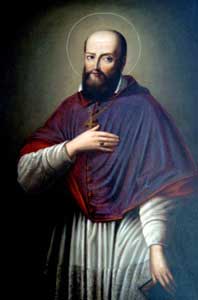 CHAPTER III. Devotion is suitable to every Vocation and Profession.
CHAPTER III. Devotion is suitable to every Vocation and Profession.
WHEN God created the world He commanded each tree to bear fruit after its kind; 88 Gen. i. 12. and even so He bids Christians,—the living trees of His Church,—to bring forth fruits of devotion, each one according to his kind and vocation.
A different exercise of devotion is required of each—the noble, the artisan, the 9 servant, the prince, the maiden and the wife; and furthermore such practice must be modified according to the strength, the calling, and the duties of each individual.
I ask you, my child, would it be fitting that a Bishop should seek to lead the solitary life of a Carthusian? And if the father of a family were as regardless in making provision for the future as a Capucin, if the artisan spent the day in church like a Religious, if the Religious involved himself in all manner of business on his neighbour’s behalf as a Bishop is called upon to do, would not such a devotion be ridiculous, ill-regulated, and intolerable? Nevertheless such a mistake is often made, and the world, which cannot or will not discriminate between real devotion and the indiscretion of those who fancy themselves devout, grumbles and finds fault with devotion, which is really nowise concerned in these errors.
No indeed, my child, the devotion which is true hinders nothing, but on the contrary it perfects everything; and that which runs counter to the rightful vocation of any one is, you may be sure, a spurious devotion.
Aristotle says that the bee sucks honey from flowers without damaging them, leaving them as whole and fresh as it found them;—but true devotion does better still, for it not only hinders no manner of vocation or duty, but, contrariwise, it adorns and beautifies all.
Throw precious 10 stones into honey, and each will grow more brilliant according to its several colour:—and in like manner everybody fulfils his special calling better when subject to the influence of devotion:—family duties are lighter, married love truer, service to our King more faithful, every kind of occupation more acceptable and better performed where that is the guide.
It is an error, nay more, a very heresy, to seek to banish the devout life from the soldier’s guardroom, the mechanic’s workshop, the prince’s court, or the domestic hearth. Of course a purely contemplative devotion, such as is specially proper to the religious and monastic life, cannot be practised in these outer vocations, but there are various other kinds of devotion well-suited to lead those whose calling is secular, along the paths of perfection. The Old Testament furnishes us examples in Abraham, Isaac and Jacob, David, Job, Tobias, Sarah, Rebecca and Judith; and in the New Testament we read of St. Joseph, Lydia and Crispus, who led a perfectly devout life in their trades:—we have S. Anne, Martha, S. Monica, Aquila and Priscilla, as examples of household devotion, Cornelius, S. Sebastian, and S. Maurice among soldiers;—Constantine, S. Helena, S. Louis, the Blessed Amadaeus, 99 It is probable that S. Francis here means to indicate Amadeo IX., Duke of Savoy, who died 1472. and 11 S. Edward on the throne. And we even find instances of some who fell away in solitude,—usually so helpful to perfection,—some who had led a higher life in the world, which seems so antagonistic to it. S. Gregory dwells on how Lot, who had kept himself pure in the city, fell in his mountain solitude. Be sure that wheresoever our lot is cast we may and must aim at the perfect life.
Check out other Discerning Hearts Posts on St. Francis de Sales
[p2p type=”id” value=”2281″]
[p2p type=”id” value=”2622″]
Meditations from the Introduction to the Devout Life by St. Francis de Sales
Tags: chapter xix, devotion, family, heresy, holy mother mary, introduction to the devout life, love, repentance, st francis de sales
This entry was posted on Thursday, January 24th, 2013 at 12:07 am
You can follow any responses to this entry through the RSS 2.0 feed.
[powerpress]
Known as the “Doer”, St. Basil the Great is an extraordinary figure in our Christian heritage.
Our Holy Father, Pope Benedict XVI has said,
Saint Basil the Great, one of the most eminent Fathers of the Eastern Church, showed to all those who wished
to give themselves completely to God the way of monastic life, “where the precept of concretely lived charity becomes the ideal of human coexistence, where the human being seeks God without limitation or impediment†(cf. Orientale Lumen, 9). Saint Basil is for you a model of perfect service of God and the Church. His whole life consisted in the harmonious exercise of the virtue of faith and in acts of practical love in the spirit of the evangelical counsels. Down the centuries the teaching of Saint Basil has borne mature fruits of religious life, especially in the East.
Take a listen to the interview above with Mike Aquilina and learn so much more about this “great” Father of the Church
Tags: faith, mike aquilina, Orientale Lumen, Saint Basil, st. basil the great, st. paul center for biblical theology
This entry was posted on Wednesday, January 2nd, 2013 at 12:05 am
You can follow any responses to this entry through the RSS 2.0 feed.
VATICAN CITY, 16 FEB 2011 (VIS) – In his general audience today, held in the Paul VI Hall, the Pope focused his attention on St. John of the Cross, “spiritual friend to St. Teresa and, with her, reformer of the Carmelite religious family. Proclaimed a Doctor of the Church by Pius XI in 1926, he is traditionally known as the ‘Doctor mysticus’, the Mystical Doctor”, the Holy Father said.
John was born to a poor family at Fontiveros near the Spanish town of Avila in 1542 and entered the Carmelite order at Medina del Campo. Ordained a priest in 1567, it was on the occasion of his first Mass that he met Teresa, “who explained to him her plan for the reform of the Carmelites”. In his renewal of his religious profession John took the name “of the Cross” and collaborated enthusiastically in the process of reform, something “which brought him great suffering”, and even led to his imprisonment following an unjust accusation. While preparing a journey to Mexico he fell seriously ill and died in December 1591. He was beatified by Clement X in
1675 and canonised by Benedict XIII in 1726.
St. John of the Cross, said Benedict XVI, “is considered one of most important lyric poets of Spanish literature. He wrote four major works: ‘Ascent of Mount Carmel’, ‘Dark Night of the Soul‘, ‘Spiritual Canticle’ and ‘Living Flame of Love‘.
“In his ‘Spiritual Canticle’ St. John outlines the soul’s journey of purification”, the Holy Father added. “The ‘Living Flame of Love’ continues in the same line, describing in greater detail the condition of union with God. … ‘Ascent of Mount Carmel’ outlines the spiritual itinerary from the point of view of a progressive purification of the soul, which is necessary in order to scale the heights of Christian perfection, symbolised by the summit of Mount Carmel”.
The Pope continued his catechesis by explaining how “the ‘Dark Night of the Soul’ describes the ‘passive’ aspect; in other words, God’s contribution to the process of purifying the soul. Human effort alone, in fact, is incapable of reaching the deepest roots of a person’s bad inclinations and habits. It can halt them but not eradicate them completely. To do this, we need a special action by God which radically purifies the spirit and disposes it to the union of love with Him“.
“The rate of increase of faith, hope and charity goes hand in hand with the work of purification and with progressive union with God, until attaining transformation into Him. When this goal is reached, the soul is immersed in Trinitarian life itself. … This is why the Mystical Doctor held that there is no true union of love with God that does not culminate in Trinitarian union”.
The Pope completed his remarks by asking whether the life of St. John of the Cross has anything to say to everyday Christians, or whether it is an example only for the few select souls who can follow the path of purification and mystical ascesis. “The journey with Christ, travelling with Christ … is not an additional weight to the already sufficiently-heavy burden of our lives”, he said. “It is something totally different. … It is a light, a power which helps us carry our everyday burden. … Allowing ourselves to be loved by Christ is the light which helps us to carry the daily burden, and sanctity is not a task we must accomplish on our own, a very difficult task. … Let us ask God to help us become saints, to allow ourselves to be loved by God, which is the vocation and true redemption of us all”.
Published by VIS – Holy See Press Office – Wednesday, February 16, 2011
Tags: ascent of mount carmel, carmelite order, carmelites, dark night of the soul, doctor of the church, family, heart, holy father, hope, love, Mystical Doctor, purification of the soul, spanish literature, spiritual friend, st. john of the cross, union with god
This entry was posted on Friday, December 14th, 2012 at 12:19 am
You can follow any responses to this entry through the RSS 2.0 feed.
“Remember always…a tranquil conscience and an assured innocence produce a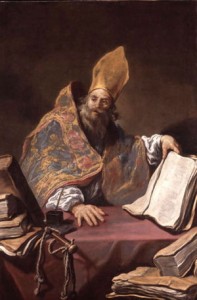 blessed life”
blessed life”
Saint Ambrose (c. between 337 and 340 – 4 April 397), was a bishop of Milan who became one of the most influential Church figures of the 4th century. Mariologist, heresy buster, emperor tamer, lover of hymns, an answer to a mother’s prayer (ask St. Monica), you name it, St. Ambrose fills the bill…
Did you know that St. Ambrose was one of the first recorded instances of someone reading silently? Interesting…
 Did you know that he received, essentially, the sacramental Grand Slam all at once? Wonder what that is?
Did you know that he received, essentially, the sacramental Grand Slam all at once? Wonder what that is?
…well let’s ask Mike Aquilina. Take a listen [powerpress]
For a fuller a rendering of his life, visit New Advent
So, so much from St. Ambrose! First, better to hear from the man himself (sort of…)
On Holy Mary
Next on Holy Repentance
A prayer of St. Ambrose
Lord Jesus Christ, I approach your banquet table in fear and trembling, for I am a sinner, and dare not rely on my own worth but only on your goodness and mercy. I am defiled by many sins in body and soul, and by my unguarded thoughts and words.
Gracious God of majesty and awe, I seek your protection, I look for your healing. Poor troubled sinner that I am, I appeal to You, the fountain of all mercy. I cannot bear your judgment, but I trust in your salvation. Lord, I show my wounds to You and uncover my shame before You. I know my sins are many and great, and they will fill me with fear, but I hope in Your Mercies, for they cannot be numbered.
Lord Jesus Christ, eternal king, God and man, crucified for mankind, look upon me with mercy and hear my prayer, for I trust in You. Have mercy on me, full of sorrow and sin, for the depth of your compassion never ends.
Praise to You, saving sacrifice, offered on the wood of the cross for me and for all mankind. Praise to the noble and precious blood, flowing from the wounds of my crucified Lord Jesus Christ and washing away the sins of the whole world. Remember, Lord, your creature, whom You have redeemed with Your Blood. I repent my sins, and I long to put right what I have done. Merciful Father, take away all my offenses and sins; purify me in body and soul, and make me worthy to taste the holy of holies.
May Your Body and Blood, which I intend to receive, although I am unworthy, be for me the remission of my sins, the washing away of my guilt, the end of my evil thoughts, and the rebirth of my better instincts. May it incite meto do the works pleasing to You and profitable to my health in body andsoul, and be a firm defense against the wiles of my enemies.
Tags: Church, conscience, doctors of the church, father of the church, fathers mike, mercy, mike aquilina, Saint Ambrose, st ambrose, st. paul center for biblical theology
This entry was posted on Friday, December 7th, 2012 at 12:21 am
You can follow any responses to this entry through the RSS 2.0 feed.
TERESA OF AVILA: CONTEMPLATIVE AND INDUSTRIOUS
VATICAN CITY, 2 FEB 2011 (vatican.va) –
Dear Brothers and Sisters,
In the course of the Catecheses that I have chosen to dedicate to the Fathers of the Church and to great theologians and women of the Middle Ages I have also had the opportunity to reflect on certain Saints proclaimed Doctors of the Church on account of the eminence of their teaching.
Today I would like to begin a brief series of meetings to complete the presentation on the Doctors of the Church and I am beginning with a Saint who is one of the peaks of Christian spirituality of all time — St Teresa of Avila [also known as St Teresa of Jesus].
St Teresa, whose name was Teresa de Cepeda y Ahumada, was born in Avila, Spain, in 1515. In her autobiography she mentions some details of her childhood: she was born into a large family, her “father and mother, who were devout and feared Godâ€, into a large family. She had three sisters and nine brothers.
While she was still a child and not yet nine years old she had the opportunity to read the lives of several Martyrs which inspired in her such a longing for martyrdom that she briefly ran away from home in order to die a Martyr’s death and to go to Heaven (cf. Vida, [Life], 1, 4); “I want to see Godâ€, the little girl told her parents.
A few years later Teresa was to speak of her childhood reading and to state that she had discovered in it the way of truth which she sums up in two fundamental principles.
On the one hand was the fact that “all things of this world will pass away†while on the other God alone is “for ever, ever, everâ€, a topic that recurs in her best known poem: “Let nothing disturb you, Let nothing frighten you, All things are passing away: God never changes. Patience obtains all things. Whoever has God lacks nothing; God alone sufficesâ€. She was about 12 years old when her mother died and she implored the Virgin Most Holy to be her mother (cf. Vida, I, 7).
If in her adolescence the reading of profane books had led to the distractions of a worldly life, her experience as a pupil of the Augustinian nuns of Santa MarÃa de las Gracias de Avila and her reading of spiritual books, especially the classics of Franciscan spirituality, introduced her to recollection and prayer.
When she was 20 she entered the Carmelite Monastery of the Incarnation, also in Avila. In her religious life she took the name “Teresa of Jesusâ€. Three years later she fell seriously ill, so ill that she remained in a coma for four days, looking as if she were dead (cf. Vida, 5, 9).
In the fight against her own illnesses too the Saint saw the combat against weaknesses and the resistance to God’s call: “I wished to liveâ€, she wrote, “but I saw clearly that I was not living, but rather wrestling with the shadow of death; there was no one to give me life, and I was not able to take it. He who could have given it to me had good reasons for not coming to my aid, seeing that he had brought me back to himself so many times, and I as often had left him†(Vida, 7, 8).
In 1543 she lost the closeness of her relatives; her father died and all her siblings, one after another, emigrated to America. In Lent 1554, when she was 39 years old, Teresa reached the climax of her struggle against her own weaknesses. The fortuitous discovery of the statue of “a Christ most grievously woundedâ€, left a deep mark on her life (cf. Vida, 9).
The Saint, who in that period felt deeply in tune with the St Augustine of the Confessions, thus describes the decisive day of her mystical experience: “and… a feeling of the presence of God would come over me unexpectedly, so that I could in no wise doubt either that he was within me, or that I was wholly absorbed in him†(Vida, 10, 1).
Parallel to her inner development, the Saint began in practice to realize her ideal of the reform of the Carmelite Order: in 1562 she founded the first reformed Carmel in Avila, with the support of the city’s Bishop, Don Alvaro de Mendoza, and shortly afterwards also received the approval of John Baptist Rossi, the Order’s Superior General.
In the years that followed, she continued her foundations of new Carmelite convents, 17 in all. Her meeting with St John of the Cross was fundamental. With him, in 1568, she set up the first convent of Discalced Carmelites in Duruelo, not far from Avila.
In 1580 she obtained from Rome the authorization for her reformed Carmels as a separate, autonomous Province. This was the starting point for the Discalced Carmelite Order.
Indeed, Teresa’s earthly life ended while she was in the middle of her founding activities. She died on the night of 15 October 1582 in Alba de Tormes, after setting up the Carmelite Convent in Burgos, while on her way back to Avila. Her last humble words were: “After all I die as a child of the Churchâ€, and “O my Lord and my Spouse, the hour that I have longed for has come. It is time to meet one anotherâ€.
Teresa spent her entire life for the whole Church although she spent it in Spain. She was beatified by Pope Paul V in 1614 and canonized by Gregory XV in 1622. The Servant of God Paul VI proclaimed her a “Doctor of the Church†in 1970.
Teresa of Jesus had no academic education but always set great store by the teachings of theologians, men of letters and spiritual teachers. As a writer, she always adhered to what she had lived personally through or had seen in the experience of others (cf. Prologue to The Way of Perfection), in other words basing herself on her own first-hand knowledge.
Teresa had the opportunity to build up relations of spiritual friendship with many Saints and with St John of the Cross in particular. At the same time she nourished herself by reading the Fathers of the Church, St Jerome, St Gregory the Great and St Augustine.
Among her most important works we should mention first of all her autobiography, El libro de la vida (the book of life), which she called Libro de las misericordias del Señor [book of the Lord’s mercies].
Written in the Carmelite Convent at Avila in 1565, she describes the biographical and spiritual journey, as she herself says, to submit her soul to the discernment of the “Master of things spiritualâ€, St John of Avila. Her purpose was to highlight the presence and action of the merciful God in her life. For this reason the work often cites her dialogue in prayer with the Lord. It makes fascinating reading because not only does the Saint recount that she is reliving the profound experience of her relationship with God but also demonstrates it.
In 1566, Teresa wrote El Camino de Perfección [The Way of Perfection]. She called itAdvertencias y consejos que da Teresa de Jesús a sus hermanas [recommendations and advice that Teresa of Jesus offers to her sisters]. It was composed for the 12 novices of the Carmel of St Joseph in Avila. Teresa proposes to them an intense programme of contemplative life at the service of the Church, at the root of which are the evangelical virtues and prayer.
Among the most precious passages is her commentary on the Our Father, as a model for prayer. St Teresa’s most famous mystical work is El Castillo interior [The Interior Castle]. She wrote it in 1577 when she was in her prime. It is a reinterpretation of her own spiritual journey and, at the same time, a codification of the possible development of Christian life towards its fullness, holiness, under the action of the Holy Spirit.
Teresa refers to the structure of a castle with seven rooms as an image of human interiority. She simultaneously introduces the symbol of the silk worm reborn as a butterfly, in order to express the passage from the natural to the supernatural.
The Saint draws inspiration from Sacred Scripture, particularly the Song of Songs, for the final symbol of the “Bride and Bridegroom†which enables her to describe, in the seventh room, the four crowning aspects of Christian life: the Trinitarian, the Christological, the anthropological and the ecclesial.
St Teresa devoted the Libro de la fundaciones [book of the foundations], which she wrote between 1573 and 1582, to her activity as Foundress of the reformed Carmels. In this book she speaks of the life of the nascent religious group. This account, like her autobiography, was written above all in order to give prominence to God’s action in the work of founding new monasteries.
It is far from easy to sum up in a few words Teresa’s profound and articulate spirituality. I would like to mention a few essential points. In the first place St Teresa proposes the evangelical virtues as the basis of all Christian and human life and in particular, detachment from possessions, that is, evangelical poverty, and this concerns all of us; love for one another as an essential element of community and social life; humility as love for the truth; determination as a fruit of Christian daring; theological hope, which she describes as the thirst for living water. Then we should not forget the human virtues: affability, truthfulness, modesty, courtesy, cheerfulness, culture.
Secondly, St Teresa proposes a profound harmony with the great biblical figures and eager listening to the word of God. She feels above all closely in tune with the Bride in the Song of Songs and with the Apostle Paul, as well as with Christ in the Passion and with Jesus in the Eucharist. The Saint then stresses how essential prayer is. Praying, she says, “means being on terms of friendship with God frequently conversing in secret with him who, we know, loves us†(Vida 8, 5). St Teresa’s idea coincides with Thomas Aquinas’ definition of theological charity as “amicitia quaedam hominis ad Deumâ€, a type of human friendship with God, who offered humanity his friendship first; it is from God that the initiative comes (cf. Summa Theologiae II-II, 23, 1).
Prayer is life and develops gradually, in pace with the growth of Christian life: it begins with vocal prayer, passes through interiorization by means of meditation and recollection, until it attains the union of love with Christ and with the Holy Trinity. Obviously, in the development of prayer climbing to the highest steps does not mean abandoning the previous type of prayer. Rather, it is a gradual deepening of the relationship with God that envelops the whole of life.
Rather than a pedagogy Teresa’s is a true “mystagogy†of prayer: she teaches those who read her works how to pray by praying with them. Indeed, she often interrupts her account or exposition with a prayerful outburst.
Another subject dear to the Saint is the centrality of Christ’s humanity. For Teresa, in fact, Christian life is the personal relationship with Jesus that culminates in union with him through grace, love and imitation. Hence the importance she attaches to meditation on the Passion and on the Eucharist as the presence of Christ in the Church for the life of every believer, and as the heart of the Liturgy. St Teresa lives out unconditional love for the Church: she shows a lively “sensus Ecclesiaeâ€, in the face of the episodes of division and conflict in the Church of her time.
She reformed the Carmelite Order with the intention of serving and defending the “Holy Roman Catholic Churchâ€, and was willing to give her life for the Church (cf. Vida, 33,5).
A final essential aspect of Teresian doctrine which I would like to emphasize
is perfection, as the aspiration of the whole of Christian life and as its ultimate goal. The Saint has a very clear idea of the “fullness†of Christ, relived by the Christian. At the end of the route through The Interior Castle, in the last “roomâ€, Teresa describes this fullness, achieved in the indwelling of the Trinity, in union with Christ through the mystery of his humanity.
Dear brothers and sisters, St Teresa of Jesus is a true teacher of Christian life for the faithful of every time. In our society, which all too often lacks spiritual values, St Teresa teaches us to be unflagging witnesses of God, of his presence and of his action. She teaches us truly to feel this thirst for God that exists in the depths of our hearts, this desire to see God, to seek God, to be in conversation with him and to be his friends.
This is the friendship we all need that we must seek anew, day after day. May the example of this Saint, profoundly contemplative and effectively active, spur us too every day to dedicate the right time to prayer, to this openness to God, to this journey, in order to seek God, to see him, to discover his friendship and so to find true life; indeed many of us should truly say: “I am not alive, I am not truly alive because I do not live the essence of my lifeâ€.
Therefore time devoted to prayer is not time wasted, it is time in which the path of life unfolds, the path unfolds to learning from God an ardent love for him, for his Church, and practical charity for our brothers and sisters. Many thanks.
Check out Teresa of Avila’s Discerning Hearts Page
Tags: st teresa, st teresa of jesus, Teresa of Avila, Teresa of Jesus
This entry was posted on Monday, October 15th, 2012 at 12:11 am
You can follow any responses to this entry through the RSS 2.0 feed.
The Novena to St. Teresa of Avila, Day 9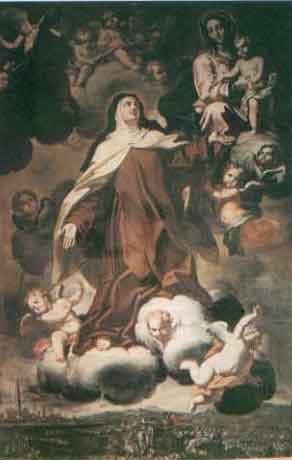
composed by  by St. Alphonsus of Liguori
Join in on Day 9 [powerpress = “devotionals-prayers”]
Teresa, making her sweetly to die of love; we pray Thee, by Thy merits, and by those of Thy most affectionate spouse, to grant us a good death; and if we do not die of love, yet, that we may at least die burning of love for Thee, that so dying, we may be able to go and love Thee for evermore with a more perfect love in heaven.
Say one Our Father, Hail Mary and Glory be.
V. St. Teresa, pray for us:
R. That we may become worthy of the promises of Jesus Christ.
Let us pray: Graciously hear us, O God of our salvation! that as we rejoice in the commemoration of the blessed virgin Teresa, so we may be nourished by her heavenly doctrine, and draw from thence the fervour of a tender devotion; through our Lord Jesus Christ, Thy Son, Who liveth and reigneth with Thee in the unity of the Holy Spirit, God for ever and ever. Amen.
This entry was posted on Sunday, October 14th, 2012 at 12:08 am
You can follow any responses to this entry through the RSS 2.0 feed.




